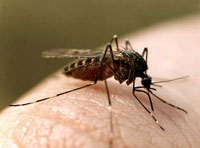US authorities begin hunting for dead birds infected with West Nile virus
Authorities of Suffolk County have activated a hotline for local residents to report occurrences of dead birds that may be infected with West Nile virus. Birds infected with that virus can often be found at pools or any other open source of water due to their thirst which they suffer from because of the viral infection. Specialists of the Suffolk County Department for Health Services will follow such reports to pick up crows, blue jays, hawks, falcons, owls, exotic or unusual bird species.

West Nile virus (or WNV) is a virus of the family Flaviviridae; part of the Japanese encephalitis (JE) antigenic complex of viruses, it is found in both tropical and temperate regions. It mainly infects birds, but is known to infect humans, horses, dogs, cats, bats, chipmunks, skunks, squirrels, and domestic rabbits. The main route of human infection is through the bite of an infected mosquito.
Image reconstructions and cryoelectron microscopy reveal a 45-50 nm virion covered with a relatively smooth protein surface. This structure is similar to the dengue fever virus; both belong to the genus Flavivirus within the family Flaviviridae. The genetic material of WNV is a positive-sense, single strand of RNA, which is between 11,000 and 12,000 nucleotides long; these genes encode seven non-structural proteins and three structural proteins. The RNA strand is held within a nucleocapsid formed from 12 kDa protein blocks; the capsid is contained within a host-derived membrane altered by two viral glycoproteins.
W.N.V. has three different effects on humans. The first is an asymptomatic infection; the second is a mild febrile syndrome termed West Nile Fever; the third is a neuroinvasive disease termed West Nile meningitis or encephalitis. In infected individuals the ratio between the three states is roughly 110:30:1.
The second, febrile stage has an incubation period of 3-8 days followed by fever, headache, chills, diaphoresis, weakness, lymphadenopathy, and drowsiness. Occasionally there is a short-lived truncal rash and some patients experience gastrointestinal symptoms including nausea, vomiting, loss of appetite, or diarrhea. All symptoms are resolved within 7-10 days, although fatigue can last for some weeks and lymphadenopathy can take up to two months to resolve.
The more dangerous encephalitis is characterized by similar early symptoms but also a decreased level of consciousness, sometimes approaching near-coma. Deep tendon reflexes are hyperactive at first, later diminished. There are also extrapyramidal disorders. Recovery is marked by a long convalescence with fatigue.
More recent outbreaks have resulted in a deeper study of the disease and other, rarer, outcomes have been identified. The spinal cord may be infected, marked by anterior myelitis with or without encephalitis. WNV-associated Guillain-Barré syndrome has been identified and other rare effects include multifocal chorioretinitis (which has 100% specificity for identifying WNV infection in patients with possible WNV encephalitis), hepatitis, myocarditis, nephritis, pancreatitis, and splenomegaly.
The virus is transmitted through mosquito vectors, which bite and infect birds. The birds are amplifying hosts, developing sufficient viral levels to transmit the infection to other biting mosquitoes which go on to infect other birds (in the Western hemisphere the American robin and the American crow are the most common carriers) and also humans. The infected mosquito species vary according to geographical area; in the US Culex pipiens (Eastern US), Culex tarsalis (Midwest and West), and Culex quinquefasciatus (Southeast) are the main sources.
Subscribe to Pravda.Ru Telegram channel, Facebook, RSS!


